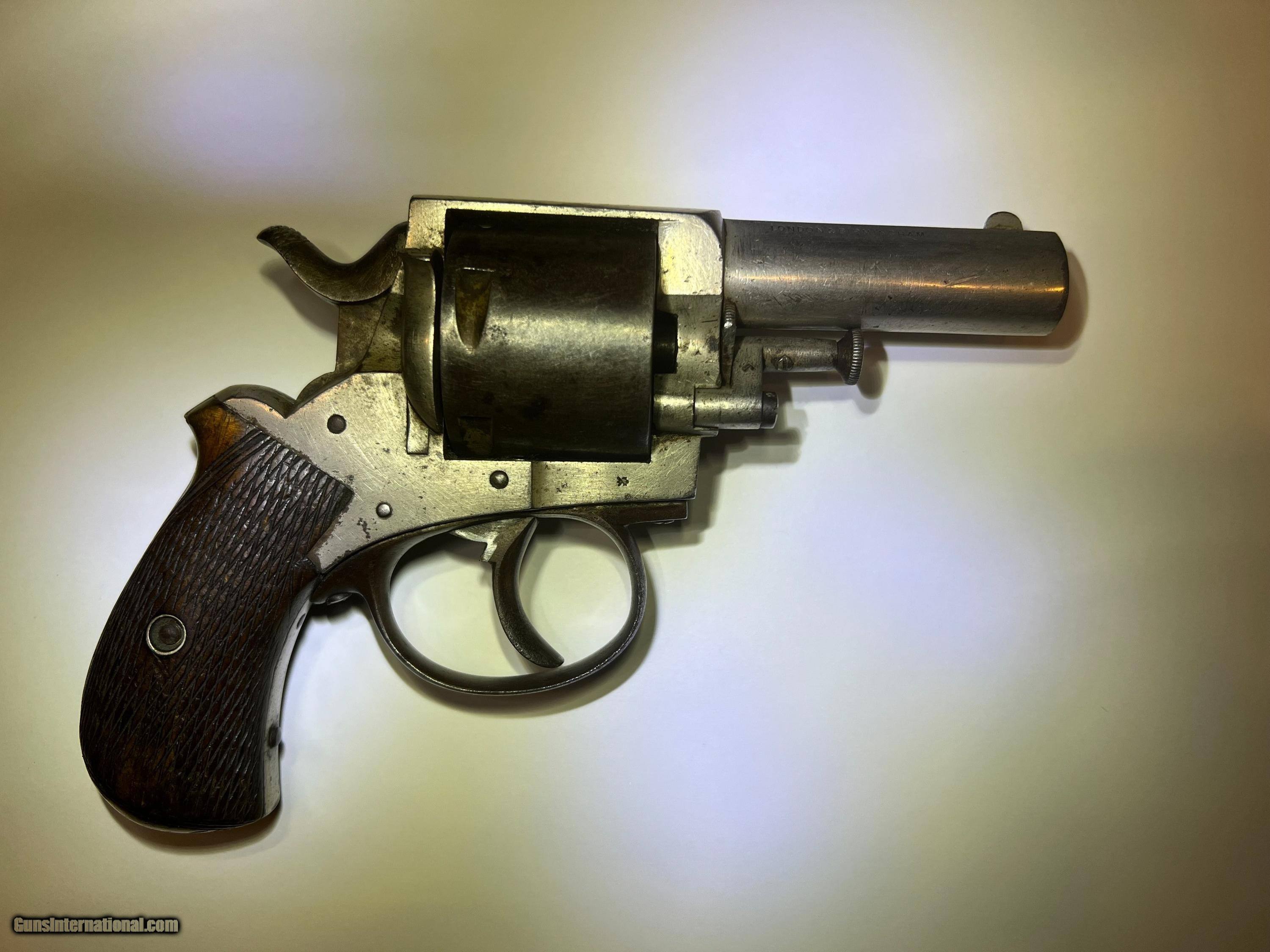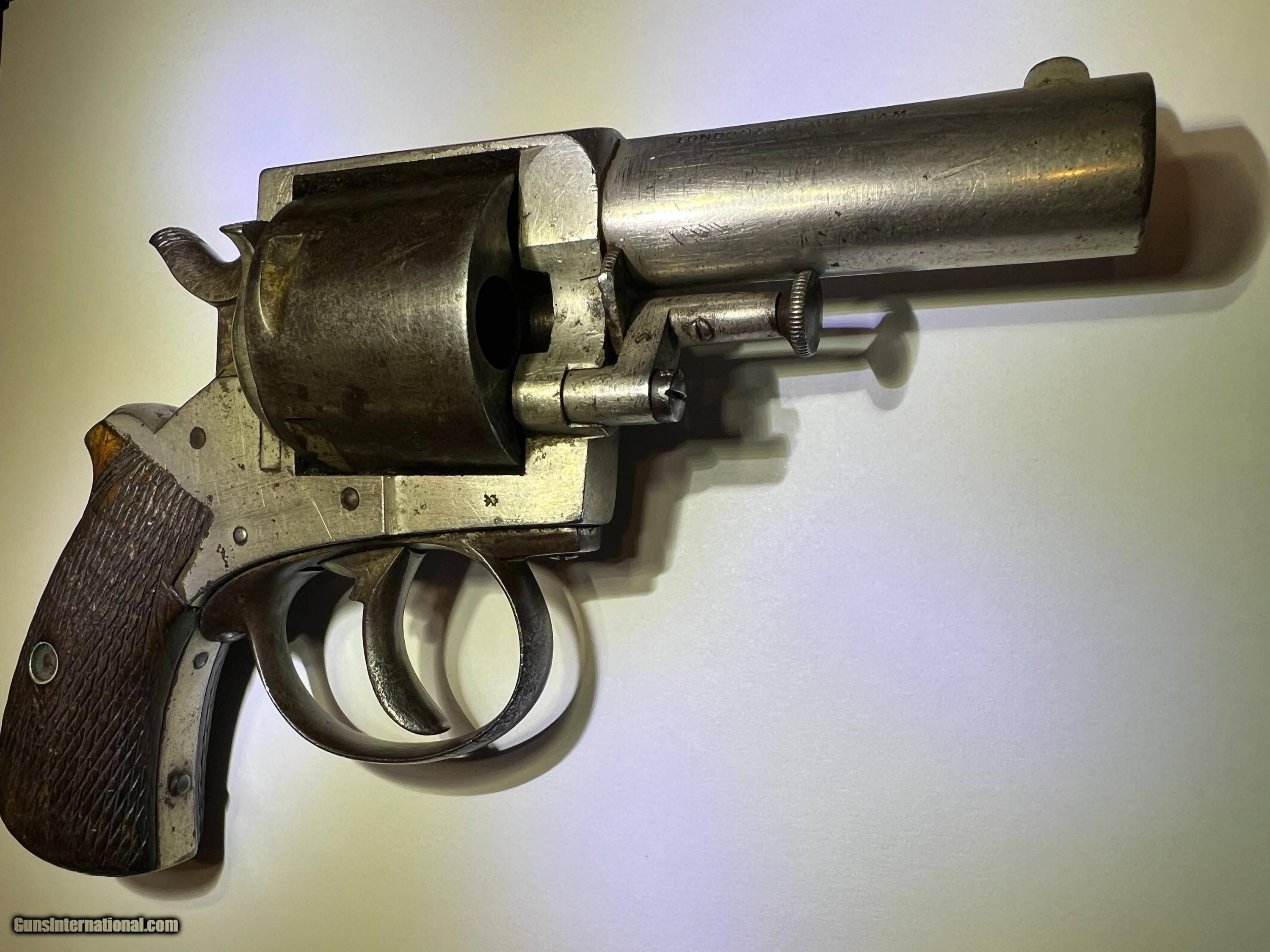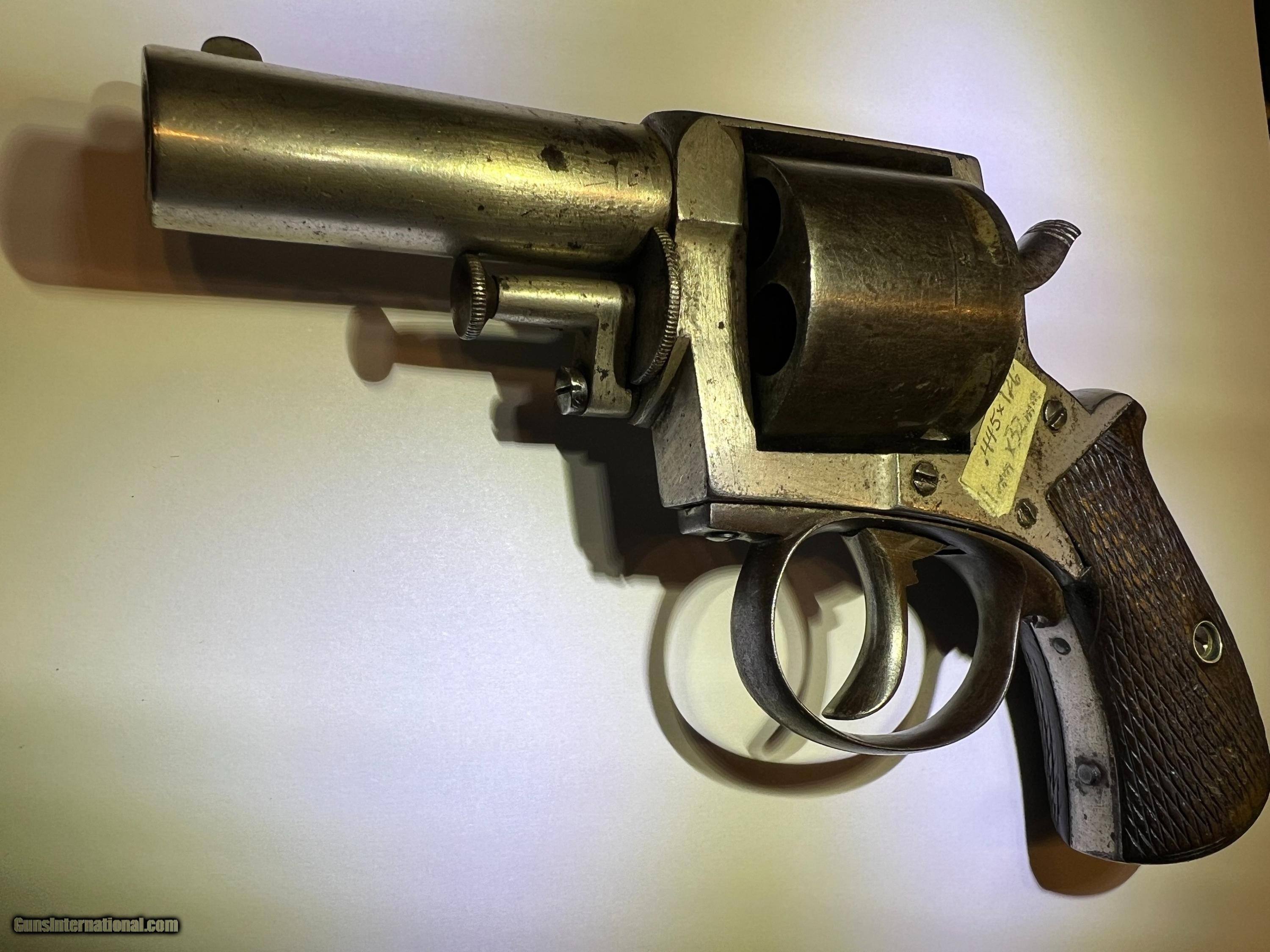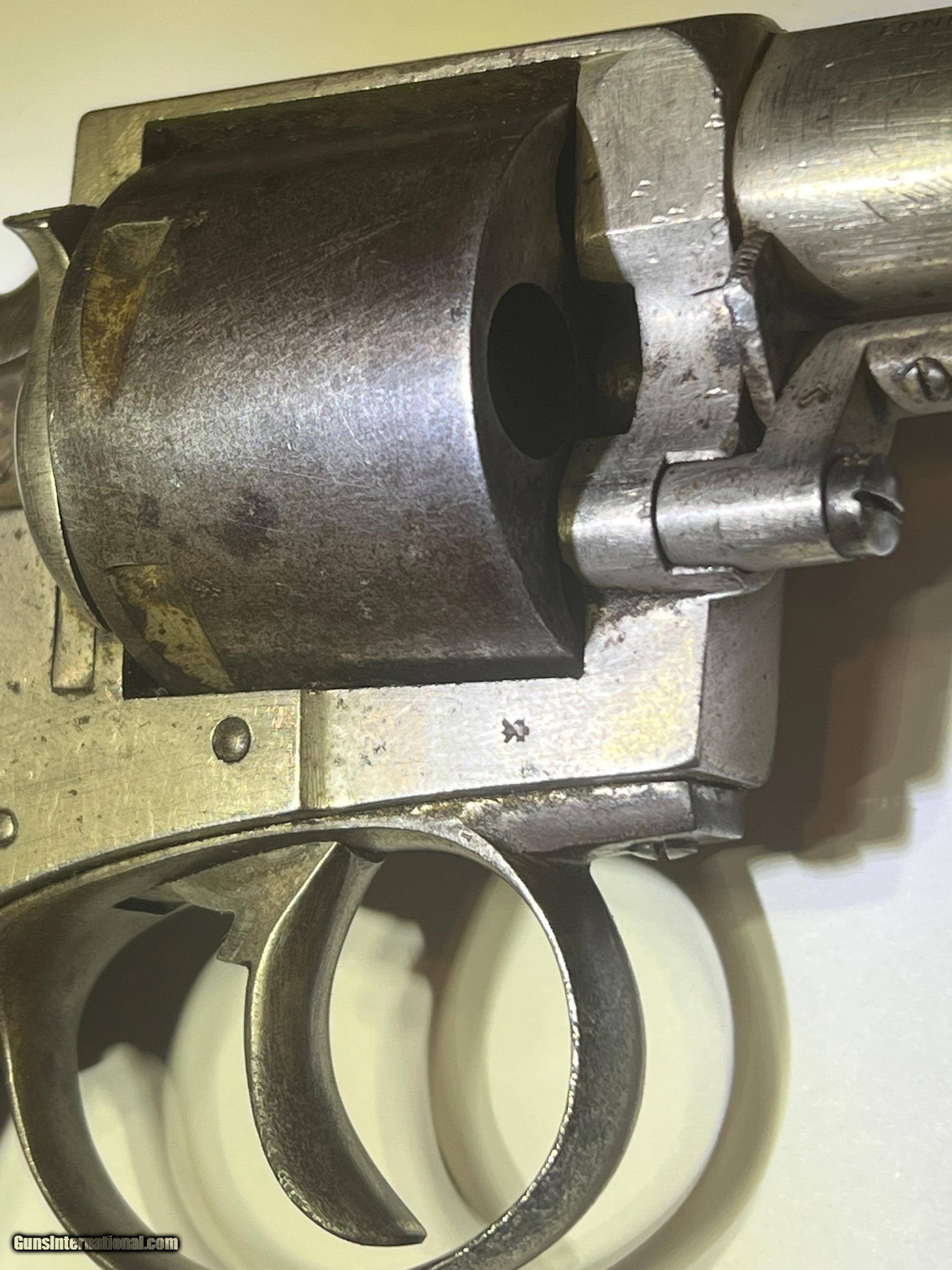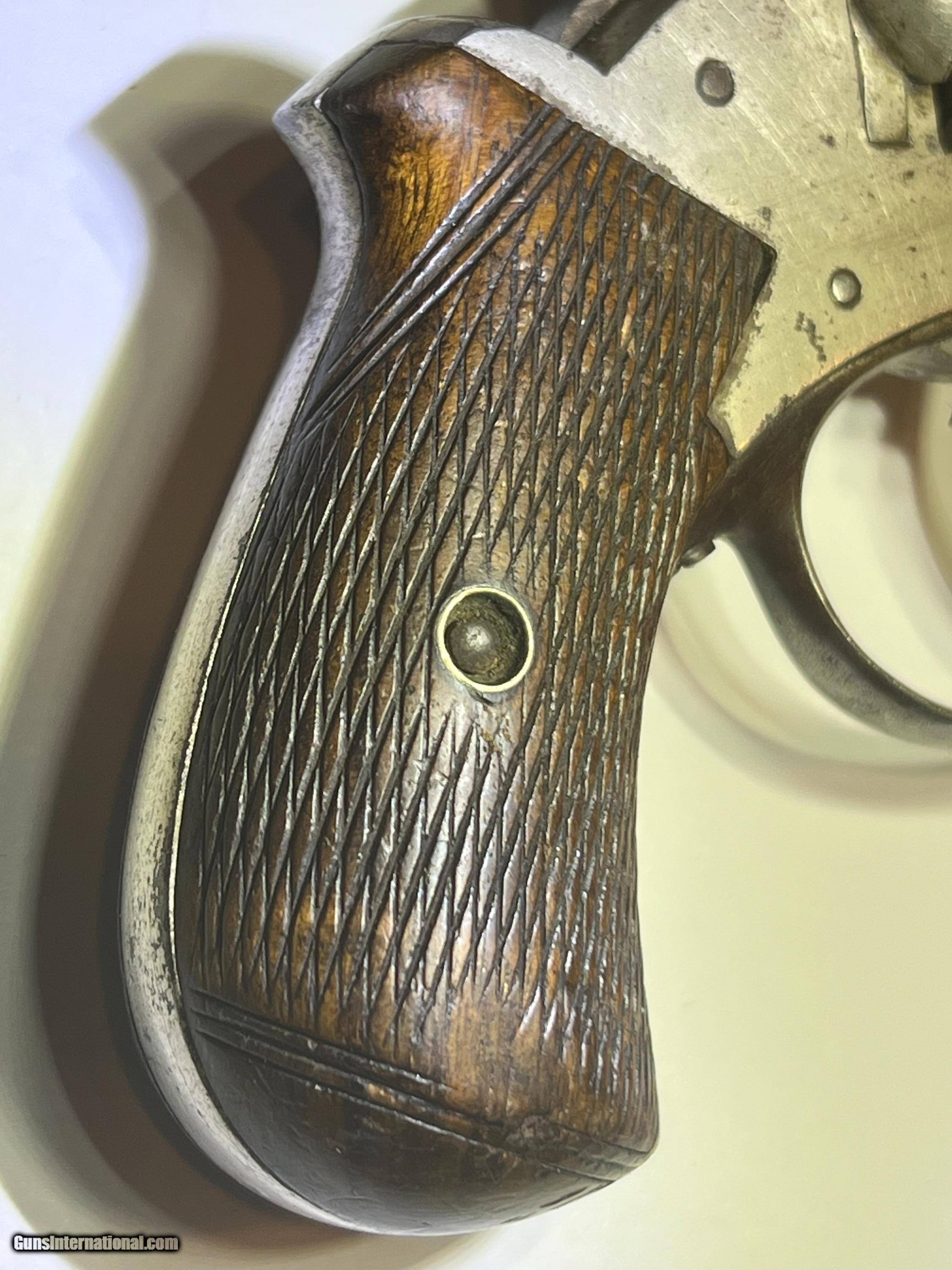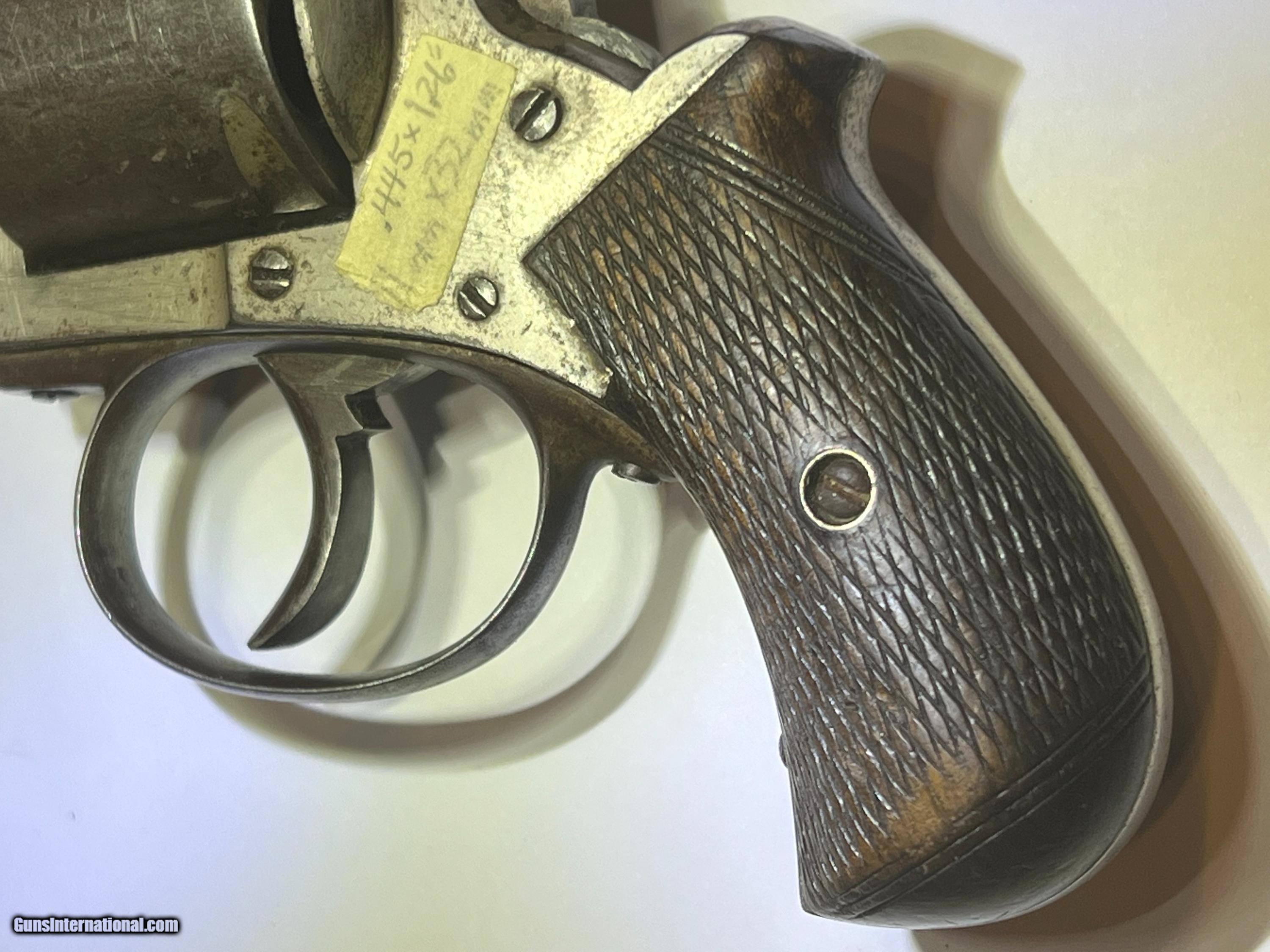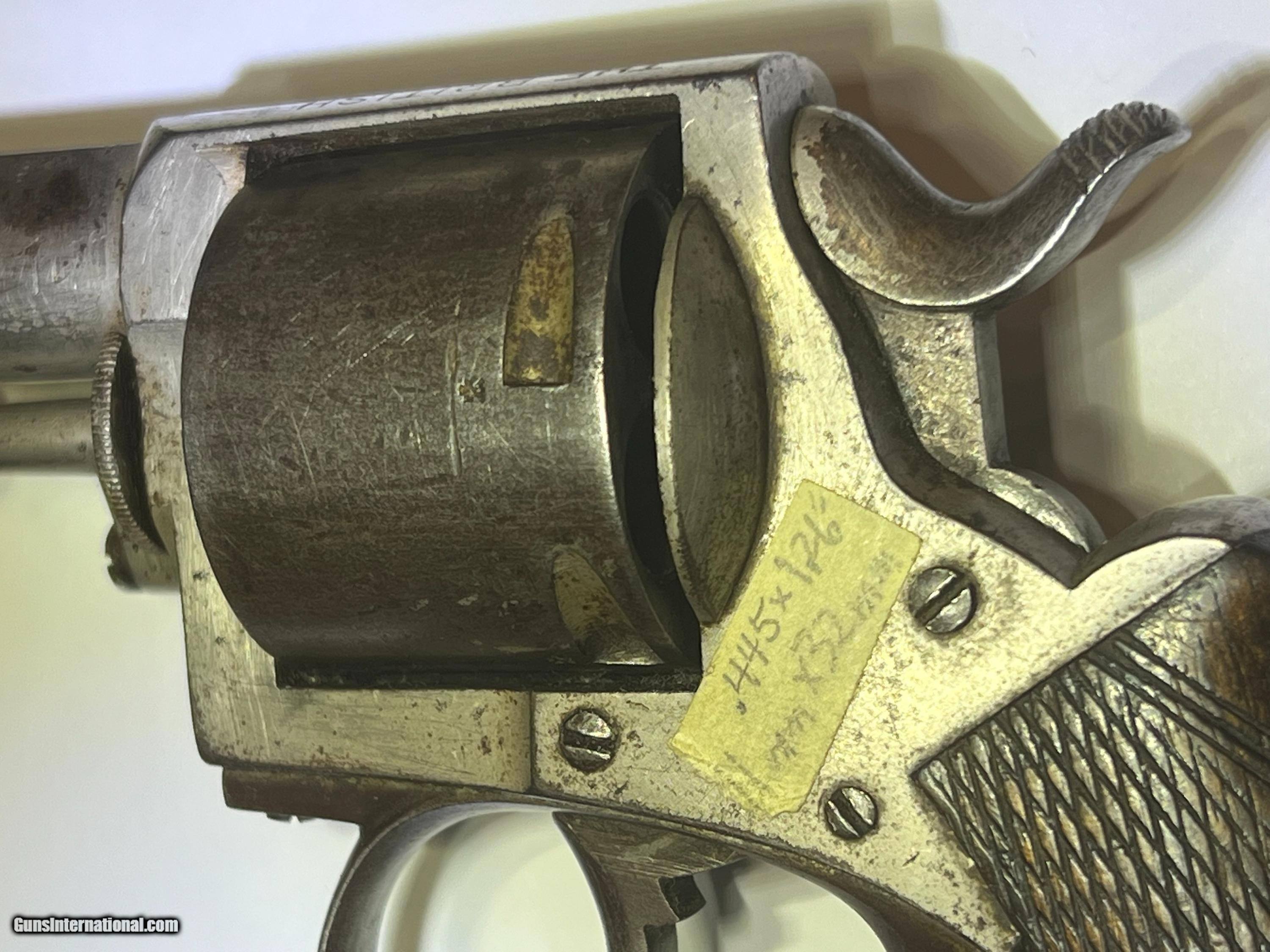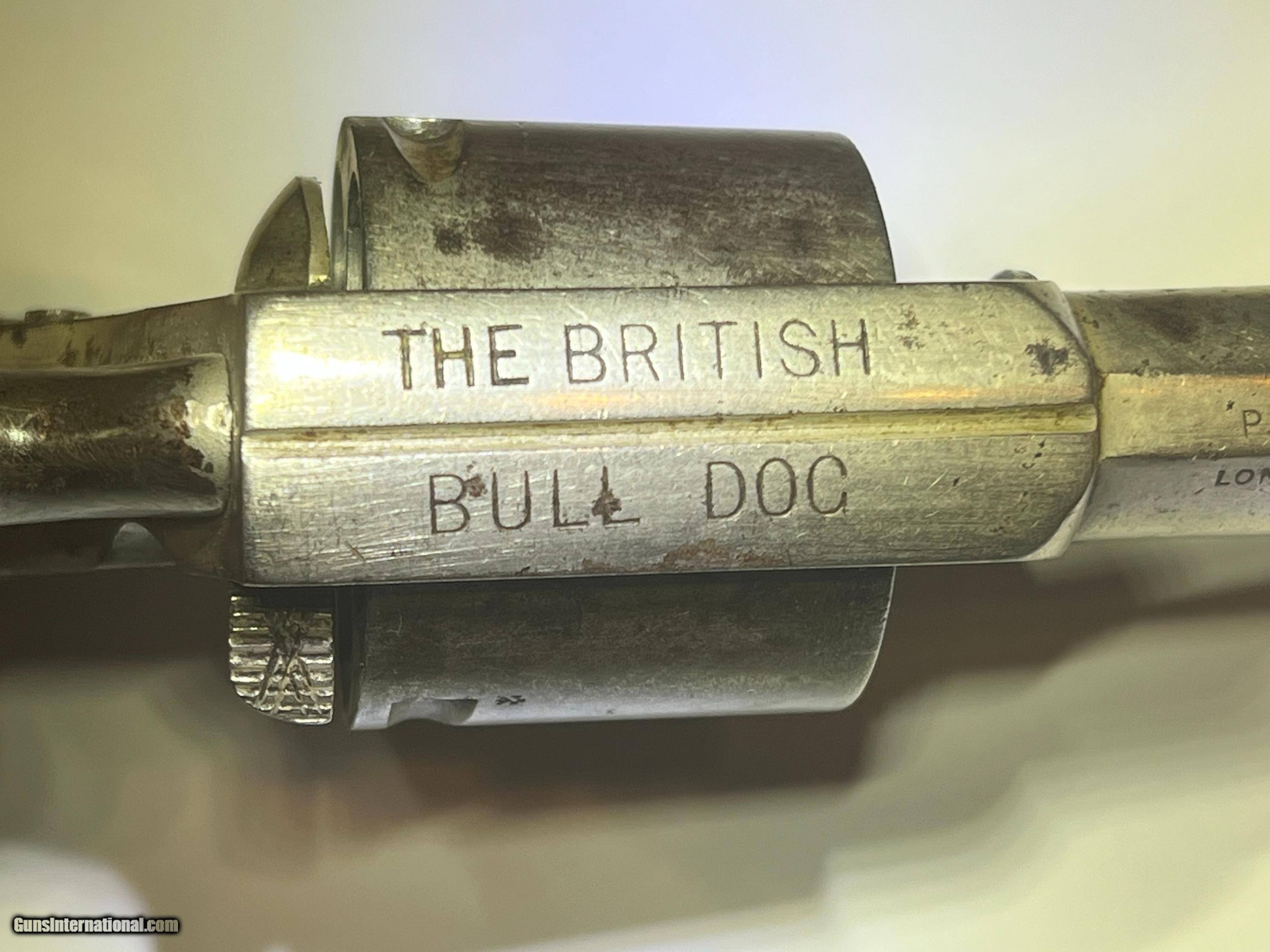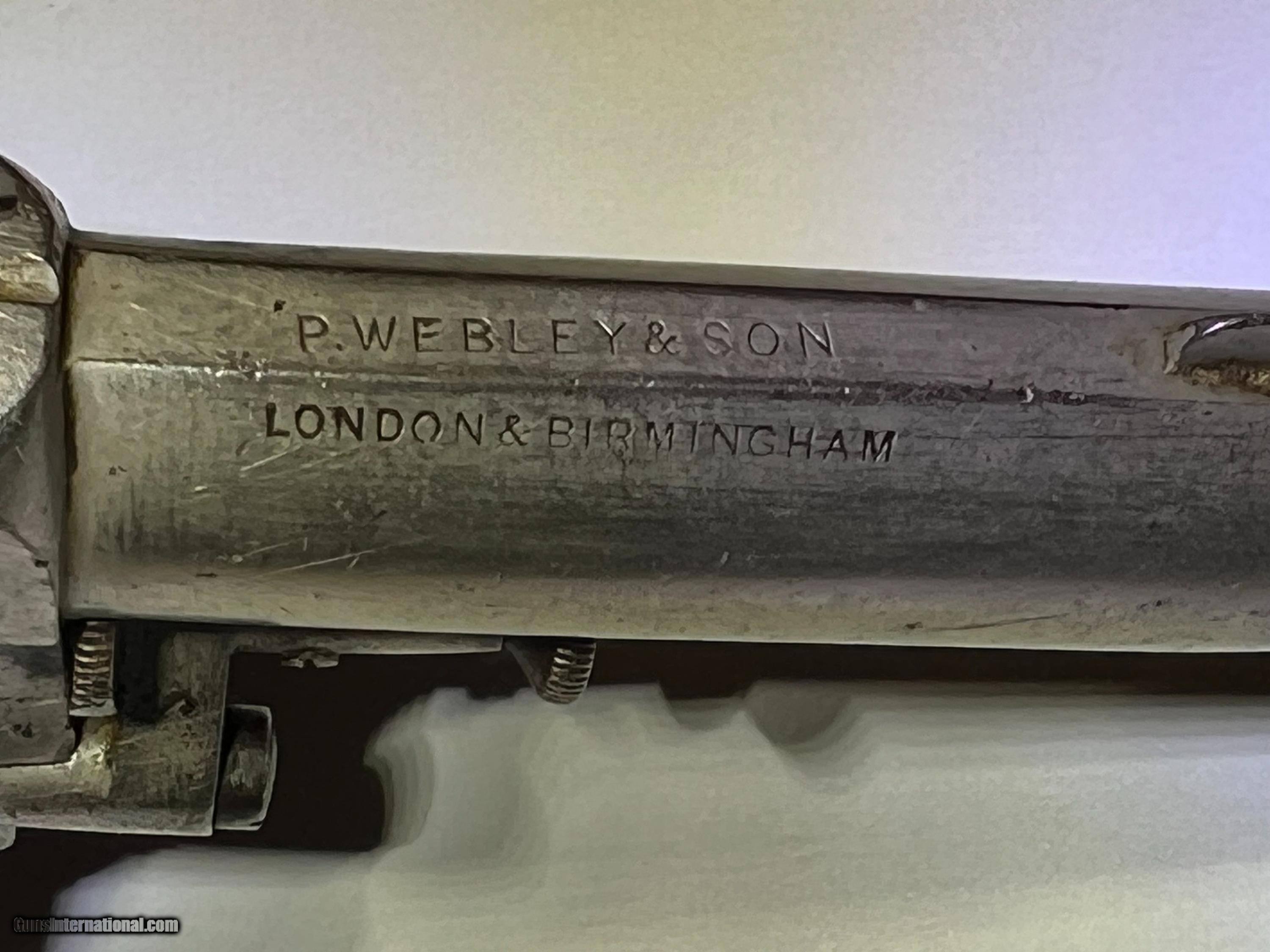Your Session is Ending
 The server has not detected any activity for the last 3 hours.
For your security, your session will expire in 2 minutes and you will be redirected to the Sign In page.
Would you like to stay signed in?
The server has not detected any activity for the last 3 hours.
For your security, your session will expire in 2 minutes and you will be redirected to the Sign In page.
Would you like to stay signed in?
Webley No.2 British Bull Dog Pattern for sale
Webley No.2 British Bull Dog Pattern for sale
Guns International #: 103056806
Seller's Inventory #: 4656
Category - .44 Revolvers
- Antiques
Webley No.2 British Bull Dog Pattern
Description:
.442 centerfire (2 1/2 in.) barrel designed and manufactured by P. Webley & Son London & Birmingham as pocket models for civilians, with model names such as British Bull Dog, The Pug, The Ulster Bull Dog, or the Tower Bull Dog. This is an original Webley British Bull Dog.
Stout and strong, these little revolvers are built like their namesake canine. With connections to a presidential assassination, an eccentric general and the Wild West, British Bulldogs may be the most collectible uncollected guns on the market.
British Bulldogs are cute but mean, bark with bite. I recently came across a beautiful Belgian-made Bulldog,
LINEAGE
The pocket revolver known primarily as the “British Bull Dog” was first produced by P. Webley & Sons of Birmingham, England, in 1872. Its appeal was so great that the “British” Bulldog was adopted and copied by gun manufacturers in Belgium, Spain, France and the U.S. Though American-made Bulldogs came from the armorers Iver Johnson, Harrington & Richardson, Forehand & Wadsworth, and several other makers who quickly went in and out of business, the Webley versions are rightly considered the real McCoy.
Though the revolver remained in production until the WWI-era, the hay day of the Bulldog was in the 1870s to 1880s, a time when it was known its affordability and reliability, consequently making it one of the most popular pocket pistols in both Europe and America. Though Colt is the brand we all know and love, and their single actions are thought to have fit the hip of near every cowboy, ranch-hand and gunslinger, Colt’s single-actions sold for three to four times the cost of the British Bulldogs. The inexpensive, yet solidly made little dogs — many of which survive as shooters today — were available to everyman.
BUILD
Though this little gun has had as many variations and names as it had makers, the general features are quite simple: a 2.5-inch barrel, five-round capacity, double-action trigger, and an overall true small-frame pocket pistol.
Bulldogs are quickly recognizable by the bird’s head grips, generally made of either walnut or pearl. However, there are many fine examples with sweet ivory grips and delicate engraving. Most had a blued finish, but some nickeled models have survived as well. The revolver is generally dressed with simple fixed sights, a large looping trigger guard, curvaceous hammer spur and weigh in around 20 ounces.
Many European Bulldogs were chambered for .44 Short, .442 Webley, .455 Webley and .450 Adams, but there are several smaller variations of Webleys chambered in .320 and .380 calibers, though they were produced much later and were never labeled as Bulldogs.
Both the American and Belgian Bulldogs, which seem to be the most prevalent on the market these days, were readily available in smaller calibers. Perhaps the most common American clones housed .44 Webley and .38 caliber chamberings.
FAMOUS TIES
The Bulldog revolver has connections both famous and infamous in American history, as detailed George Layman’s book “The British Bulldog Revolver: The Forgotten Gun that Really Won the West!”
Probably the most infamous connection places it in the hands of Charles Guiteau, the man who shot President James Garfield in 1881. Though the wounded President lived for several months under the rudimentary medical care of the time, he succumbed to the pair of bullet wounds almost three-months later.
As the story goes, Guiteau was reportedly furious that Garfield overlooked him for appointment to a federal post and vowed to take vengeance on the President — and to do so with a good-looking gun, but one that could be had on a budget.
Guiteau is said to have used a Belgian-made British Bulldog in .44 caliber, but interestingly there is some debate over whether Guiteau got his wish of acquiring one with ivory grips. As rumor has it, he wanted his gun to look good when it eventually made its way to a museum, but the ivory upgrade cost several dollars more than the walnut model, which sold in the $8 to $12 range. The gun commonly shown as Guiteau’s model in period illustrations has walnut grips, but the actual gun is, in fact, long gone. Following Guiteau’s trial, the revolver was on loan to the Smithsonian, but, a short time later, the revolver disappeared and has not been found to this day. It is unclear whether the gun disappeared during its stay with the museum or sometime later.
In addition to the Garfield-Guiteau history, British Bulldogs found their way into the pockets and holsters of other famous characters. Gen. George Custer is rumored to have wielded a matched pair of ivory handled British Bulldog revolvers.
A British Bulldog may also have fallen into the hands of William Bonney, aka Billy the Kid, by way of his first employer and mentor, John H. Tunstall. Whether this gun ever saw any dubious service remains for great speculation, but regardless, the little British Bulldogs were as well traveled as they were well loved.
COLLECTABILITY TODAY
The large-caliber British Bulldogs, particularly the original Webleys, are considered both the most collectible and generally the most valuable. As the dogs were true pocket pistols, though often carried, the majority of them saw quite light use. While the patina on them shows the beauty of age, many survive in surprisingly nice condition today. Though British Bulldogs will never carry the fame or value of Colt single-actions, the dogs were cheaper yet dependable and thus available to the common workingman.
Manufacturer: P. Webley & Son
Model: The British Bull Dog
Serial Number: None
Barrel Length: 2.5
Condition: V.G.
Metal Condition: V.G.
Wood Condition: V.G.
Bore Condition: Good
Manufacture Date: 1880
Price: $2,250.00
Description:
.442 centerfire (2 1/2 in.) barrel designed and manufactured by P. Webley & Son London & Birmingham as pocket models for civilians, with model names such as British Bull Dog, The Pug, The Ulster Bull Dog, or the Tower Bull Dog. This is an original Webley British Bull Dog.
Stout and strong, these little revolvers are built like their namesake canine. With connections to a presidential assassination, an eccentric general and the Wild West, British Bulldogs may be the most collectible uncollected guns on the market.
British Bulldogs are cute but mean, bark with bite. I recently came across a beautiful Belgian-made Bulldog,
LINEAGE
The pocket revolver known primarily as the “British Bull Dog” was first produced by P. Webley & Sons of Birmingham, England, in 1872. Its appeal was so great that the “British” Bulldog was adopted and copied by gun manufacturers in Belgium, Spain, France and the U.S. Though American-made Bulldogs came from the armorers Iver Johnson, Harrington & Richardson, Forehand & Wadsworth, and several other makers who quickly went in and out of business, the Webley versions are rightly considered the real McCoy.
Though the revolver remained in production until the WWI-era, the hay day of the Bulldog was in the 1870s to 1880s, a time when it was known its affordability and reliability, consequently making it one of the most popular pocket pistols in both Europe and America. Though Colt is the brand we all know and love, and their single actions are thought to have fit the hip of near every cowboy, ranch-hand and gunslinger, Colt’s single-actions sold for three to four times the cost of the British Bulldogs. The inexpensive, yet solidly made little dogs — many of which survive as shooters today — were available to everyman.
BUILD
Though this little gun has had as many variations and names as it had makers, the general features are quite simple: a 2.5-inch barrel, five-round capacity, double-action trigger, and an overall true small-frame pocket pistol.
Bulldogs are quickly recognizable by the bird’s head grips, generally made of either walnut or pearl. However, there are many fine examples with sweet ivory grips and delicate engraving. Most had a blued finish, but some nickeled models have survived as well. The revolver is generally dressed with simple fixed sights, a large looping trigger guard, curvaceous hammer spur and weigh in around 20 ounces.
Many European Bulldogs were chambered for .44 Short, .442 Webley, .455 Webley and .450 Adams, but there are several smaller variations of Webleys chambered in .320 and .380 calibers, though they were produced much later and were never labeled as Bulldogs.
Both the American and Belgian Bulldogs, which seem to be the most prevalent on the market these days, were readily available in smaller calibers. Perhaps the most common American clones housed .44 Webley and .38 caliber chamberings.
FAMOUS TIES
The Bulldog revolver has connections both famous and infamous in American history, as detailed George Layman’s book “The British Bulldog Revolver: The Forgotten Gun that Really Won the West!”
Probably the most infamous connection places it in the hands of Charles Guiteau, the man who shot President James Garfield in 1881. Though the wounded President lived for several months under the rudimentary medical care of the time, he succumbed to the pair of bullet wounds almost three-months later.
As the story goes, Guiteau was reportedly furious that Garfield overlooked him for appointment to a federal post and vowed to take vengeance on the President — and to do so with a good-looking gun, but one that could be had on a budget.
Guiteau is said to have used a Belgian-made British Bulldog in .44 caliber, but interestingly there is some debate over whether Guiteau got his wish of acquiring one with ivory grips. As rumor has it, he wanted his gun to look good when it eventually made its way to a museum, but the ivory upgrade cost several dollars more than the walnut model, which sold in the $8 to $12 range. The gun commonly shown as Guiteau’s model in period illustrations has walnut grips, but the actual gun is, in fact, long gone. Following Guiteau’s trial, the revolver was on loan to the Smithsonian, but, a short time later, the revolver disappeared and has not been found to this day. It is unclear whether the gun disappeared during its stay with the museum or sometime later.
In addition to the Garfield-Guiteau history, British Bulldogs found their way into the pockets and holsters of other famous characters. Gen. George Custer is rumored to have wielded a matched pair of ivory handled British Bulldog revolvers.
A British Bulldog may also have fallen into the hands of William Bonney, aka Billy the Kid, by way of his first employer and mentor, John H. Tunstall. Whether this gun ever saw any dubious service remains for great speculation, but regardless, the little British Bulldogs were as well traveled as they were well loved.
COLLECTABILITY TODAY
The large-caliber British Bulldogs, particularly the original Webleys, are considered both the most collectible and generally the most valuable. As the dogs were true pocket pistols, though often carried, the majority of them saw quite light use. While the patina on them shows the beauty of age, many survive in surprisingly nice condition today. Though British Bulldogs will never carry the fame or value of Colt single-actions, the dogs were cheaper yet dependable and thus available to the common workingman.
Manufacturer: P. Webley & Son
Model: The British Bull Dog
Serial Number: None
Barrel Length: 2.5
Condition: V.G.
Metal Condition: V.G.
Wood Condition: V.G.
Bore Condition: Good
Manufacture Date: 1880
Price: $2,250.00
Contact Seller
Click Photo to Enlarge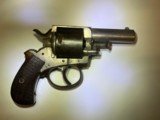
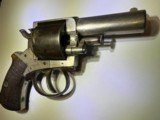
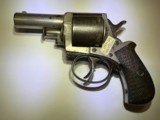
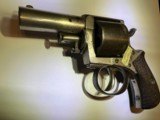
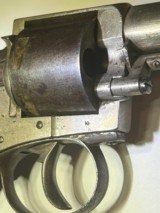
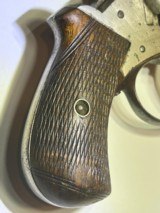
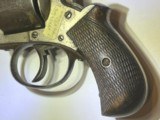
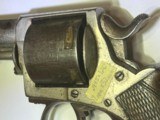
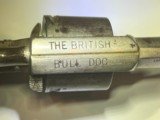
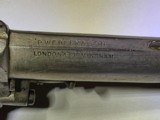
|
Guns International #: 103056806
Category - .44 Revolvers
- Antiques
Webley No.2 British Bull Dog Pattern
Description: .442 centerfire (2 1/2 in.) barrel designed and manufactured by P. Webley & Son London & Birmingham as pocket models for civilians, with model names such as British Bull Dog, The Pug, The Ulster Bull Dog, or the Tower Bull Dog. This is an original Webley British Bull Dog. Stout and strong, these little revolvers are built like their namesake canine. With connections to a presidential assassination, an eccentric general and the Wild West, British Bulldogs may be the most collectible uncollected guns on the market. British Bulldogs are cute but mean, bark with bite. I recently came across a beautiful Belgian-made Bulldog, LINEAGE The pocket revolver known primarily as the “British Bull Dog” was first produced by P. Webley & Sons of Birmingham, England, in 1872. Its appeal was so great that the “British” Bulldog was adopted and copied by gun manufacturers in Belgium, Spain, France and the U.S. Though American-made Bulldogs came from the armorers Iver Johnson, Harrington & Richardson, Forehand & Wadsworth, and several other makers who quickly went in and out of business, the Webley versions are rightly considered the real McCoy. Though the revolver remained in production until the WWI-era, the hay day of the Bulldog was in the 1870s to 1880s, a time when it was known its affordability and reliability, consequently making it one of the most popular pocket pistols in both Europe and America. Though Colt is the brand we all know and love, and their single actions are thought to have fit the hip of near every cowboy, ranch-hand and gunslinger, Colt’s single-actions sold for three to four times the cost of the British Bulldogs. The inexpensive, yet solidly made little dogs — many of which survive as shooters today — were available to everyman. BUILD Though this little gun has had as many variations and names as it had makers, the general features are quite simple: a 2.5-inch barrel, five-round capacity, double-action trigger, and an overall true small-frame pocket pistol. Bulldogs are quickly recognizable by the bird’s head grips, generally made of either walnut or pearl. However, there are many fine examples with sweet ivory grips and delicate engraving. Most had a blued finish, but some nickeled models have survived as well. The revolver is generally dressed with simple fixed sights, a large looping trigger guard, curvaceous hammer spur and weigh in around 20 ounces. Many European Bulldogs were chambered for .44 Short, .442 Webley, .455 Webley and .450 Adams, but there are several smaller variations of Webleys chambered in .320 and .380 calibers, though they were produced much later and were never labeled as Bulldogs. Both the American and Belgian Bulldogs, which seem to be the most prevalent on the market these days, were readily available in smaller calibers. Perhaps the most common American clones housed .44 Webley and .38 caliber chamberings. FAMOUS TIES The Bulldog revolver has connections both famous and infamous in American history, as detailed George Layman’s book “The British Bulldog Revolver: The Forgotten Gun that Really Won the West!” Probably the most infamous connection places it in the hands of Charles Guiteau, the man who shot President James Garfield in 1881. Though the wounded President lived for several months under the rudimentary medical care of the time, he succumbed to the pair of bullet wounds almost three-months later. As the story goes, Guiteau was reportedly furious that Garfield overlooked him for appointment to a federal post and vowed to take vengeance on the President — and to do so with a good-looking gun, but one that could be had on a budget. Guiteau is said to have used a Belgian-made British Bulldog in .44 caliber, but interestingly there is some debate over whether Guiteau got his wish of acquiring one with ivory grips. As rumor has it, he wanted his gun to look good when it eventually made its way to a museum, but the ivory upgrade cost several dollars more than the walnut model, which sold in the $8 to $12 range. The gun commonly shown as Guiteau’s model in period illustrations has walnut grips, but the actual gun is, in fact, long gone. Following Guiteau’s trial, the revolver was on loan to the Smithsonian, but, a short time later, the revolver disappeared and has not been found to this day. It is unclear whether the gun disappeared during its stay with the museum or sometime later. In addition to the Garfield-Guiteau history, British Bulldogs found their way into the pockets and holsters of other famous characters. Gen. George Custer is rumored to have wielded a matched pair of ivory handled British Bulldog revolvers. A British Bulldog may also have fallen into the hands of William Bonney, aka Billy the Kid, by way of his first employer and mentor, John H. Tunstall. Whether this gun ever saw any dubious service remains for great speculation, but regardless, the little British Bulldogs were as well traveled as they were well loved. COLLECTABILITY TODAY The large-caliber British Bulldogs, particularly the original Webleys, are considered both the most collectible and generally the most valuable. As the dogs were true pocket pistols, though often carried, the majority of them saw quite light use. While the patina on them shows the beauty of age, many survive in surprisingly nice condition today. Though British Bulldogs will never carry the fame or value of Colt single-actions, the dogs were cheaper yet dependable and thus available to the common workingman. Manufacturer: P. Webley & Son Model: The British Bull Dog Serial Number: None Barrel Length: 2.5 Condition: V.G. Metal Condition: V.G. Wood Condition: V.G. Bore Condition: Good Manufacture Date: 1880 Price: $2,250.00 Contact Seller |
Guns International #: 103056806
Seller's Inventory #: 4656
Category - .44 Revolvers
- Antiques
Webley No.2 British Bull Dog Pattern
Description:
.442 centerfire (2 1/2 in.) barrel designed and manufactured by P. Webley & Son London & Birmingham as pocket models for civilians, with model names such as British Bull Dog, The Pug, The Ulster Bull Dog, or the Tower Bull Dog. This is an original Webley British Bull Dog.
Stout and strong, these little revolvers are built like their namesake canine. With connections to a presidential assassination, an eccentric general and the Wild West, British Bulldogs may be the most collectible uncollected guns on the market.
British Bulldogs are cute but mean, bark with bite. I recently came across a beautiful Belgian-made Bulldog,
LINEAGE
The pocket revolver known primarily as the “British Bull Dog” was first produced by P. Webley & Sons of Birmingham, England, in 1872. Its appeal was so great that the “British” Bulldog was adopted and copied by gun manufacturers in Belgium, Spain, France and the U.S. Though American-made Bulldogs came from the armorers Iver Johnson, Harrington & Richardson, Forehand & Wadsworth, and several other makers who quickly went in and out of business, the Webley versions are rightly considered the real McCoy.
Though the revolver remained in production until the WWI-era, the hay day of the Bulldog was in the 1870s to 1880s, a time when it was known its affordability and reliability, consequently making it one of the most popular pocket pistols in both Europe and America. Though Colt is the brand we all know and love, and their single actions are thought to have fit the hip of near every cowboy, ranch-hand and gunslinger, Colt’s single-actions sold for three to four times the cost of the British Bulldogs. The inexpensive, yet solidly made little dogs — many of which survive as shooters today — were available to everyman.
BUILD
Though this little gun has had as many variations and names as it had makers, the general features are quite simple: a 2.5-inch barrel, five-round capacity, double-action trigger, and an overall true small-frame pocket pistol.
Bulldogs are quickly recognizable by the bird’s head grips, generally made of either walnut or pearl. However, there are many fine examples with sweet ivory grips and delicate engraving. Most had a blued finish, but some nickeled models have survived as well. The revolver is generally dressed with simple fixed sights, a large looping trigger guard, curvaceous hammer spur and weigh in around 20 ounces.
Many European Bulldogs were chambered for .44 Short, .442 Webley, .455 Webley and .450 Adams, but there are several smaller variations of Webleys chambered in .320 and .380 calibers, though they were produced much later and were never labeled as Bulldogs.
Both the American and Belgian Bulldogs, which seem to be the most prevalent on the market these days, were readily available in smaller calibers. Perhaps the most common American clones housed .44 Webley and .38 caliber chamberings.
FAMOUS TIES
The Bulldog revolver has connections both famous and infamous in American history, as detailed George Layman’s book “The British Bulldog Revolver: The Forgotten Gun that Really Won the West!”
Probably the most infamous connection places it in the hands of Charles Guiteau, the man who shot President James Garfield in 1881. Though the wounded President lived for several months under the rudimentary medical care of the time, he succumbed to the pair of bullet wounds almost three-months later.
As the story goes, Guiteau was reportedly furious that Garfield overlooked him for appointment to a federal post and vowed to take vengeance on the President — and to do so with a good-looking gun, but one that could be had on a budget.
Guiteau is said to have used a Belgian-made British Bulldog in .44 caliber, but interestingly there is some debate over whether Guiteau got his wish of acquiring one with ivory grips. As rumor has it, he wanted his gun to look good when it eventually made its way to a museum, but the ivory upgrade cost several dollars more than the walnut model, which sold in the $8 to $12 range. The gun commonly shown as Guiteau’s model in period illustrations has walnut grips, but the actual gun is, in fact, long gone. Following Guiteau’s trial, the revolver was on loan to the Smithsonian, but, a short time later, the revolver disappeared and has not been found to this day. It is unclear whether the gun disappeared during its stay with the museum or sometime later.
In addition to the Garfield-Guiteau history, British Bulldogs found their way into the pockets and holsters of other famous characters. Gen. George Custer is rumored to have wielded a matched pair of ivory handled British Bulldog revolvers.
A British Bulldog may also have fallen into the hands of William Bonney, aka Billy the Kid, by way of his first employer and mentor, John H. Tunstall. Whether this gun ever saw any dubious service remains for great speculation, but regardless, the little British Bulldogs were as well traveled as they were well loved.
COLLECTABILITY TODAY
The large-caliber British Bulldogs, particularly the original Webleys, are considered both the most collectible and generally the most valuable. As the dogs were true pocket pistols, though often carried, the majority of them saw quite light use. While the patina on them shows the beauty of age, many survive in surprisingly nice condition today. Though British Bulldogs will never carry the fame or value of Colt single-actions, the dogs were cheaper yet dependable and thus available to the common workingman.
Manufacturer: P. Webley & Son
Model: The British Bull Dog
Serial Number: None
Barrel Length: 2.5
Condition: V.G.
Metal Condition: V.G.
Wood Condition: V.G.
Bore Condition: Good
Manufacture Date: 1880
Price: $2,250.00
Description:
.442 centerfire (2 1/2 in.) barrel designed and manufactured by P. Webley & Son London & Birmingham as pocket models for civilians, with model names such as British Bull Dog, The Pug, The Ulster Bull Dog, or the Tower Bull Dog. This is an original Webley British Bull Dog.
Stout and strong, these little revolvers are built like their namesake canine. With connections to a presidential assassination, an eccentric general and the Wild West, British Bulldogs may be the most collectible uncollected guns on the market.
British Bulldogs are cute but mean, bark with bite. I recently came across a beautiful Belgian-made Bulldog,
LINEAGE
The pocket revolver known primarily as the “British Bull Dog” was first produced by P. Webley & Sons of Birmingham, England, in 1872. Its appeal was so great that the “British” Bulldog was adopted and copied by gun manufacturers in Belgium, Spain, France and the U.S. Though American-made Bulldogs came from the armorers Iver Johnson, Harrington & Richardson, Forehand & Wadsworth, and several other makers who quickly went in and out of business, the Webley versions are rightly considered the real McCoy.
Though the revolver remained in production until the WWI-era, the hay day of the Bulldog was in the 1870s to 1880s, a time when it was known its affordability and reliability, consequently making it one of the most popular pocket pistols in both Europe and America. Though Colt is the brand we all know and love, and their single actions are thought to have fit the hip of near every cowboy, ranch-hand and gunslinger, Colt’s single-actions sold for three to four times the cost of the British Bulldogs. The inexpensive, yet solidly made little dogs — many of which survive as shooters today — were available to everyman.
BUILD
Though this little gun has had as many variations and names as it had makers, the general features are quite simple: a 2.5-inch barrel, five-round capacity, double-action trigger, and an overall true small-frame pocket pistol.
Bulldogs are quickly recognizable by the bird’s head grips, generally made of either walnut or pearl. However, there are many fine examples with sweet ivory grips and delicate engraving. Most had a blued finish, but some nickeled models have survived as well. The revolver is generally dressed with simple fixed sights, a large looping trigger guard, curvaceous hammer spur and weigh in around 20 ounces.
Many European Bulldogs were chambered for .44 Short, .442 Webley, .455 Webley and .450 Adams, but there are several smaller variations of Webleys chambered in .320 and .380 calibers, though they were produced much later and were never labeled as Bulldogs.
Both the American and Belgian Bulldogs, which seem to be the most prevalent on the market these days, were readily available in smaller calibers. Perhaps the most common American clones housed .44 Webley and .38 caliber chamberings.
FAMOUS TIES
The Bulldog revolver has connections both famous and infamous in American history, as detailed George Layman’s book “The British Bulldog Revolver: The Forgotten Gun that Really Won the West!”
Probably the most infamous connection places it in the hands of Charles Guiteau, the man who shot President James Garfield in 1881. Though the wounded President lived for several months under the rudimentary medical care of the time, he succumbed to the pair of bullet wounds almost three-months later.
As the story goes, Guiteau was reportedly furious that Garfield overlooked him for appointment to a federal post and vowed to take vengeance on the President — and to do so with a good-looking gun, but one that could be had on a budget.
Guiteau is said to have used a Belgian-made British Bulldog in .44 caliber, but interestingly there is some debate over whether Guiteau got his wish of acquiring one with ivory grips. As rumor has it, he wanted his gun to look good when it eventually made its way to a museum, but the ivory upgrade cost several dollars more than the walnut model, which sold in the $8 to $12 range. The gun commonly shown as Guiteau’s model in period illustrations has walnut grips, but the actual gun is, in fact, long gone. Following Guiteau’s trial, the revolver was on loan to the Smithsonian, but, a short time later, the revolver disappeared and has not been found to this day. It is unclear whether the gun disappeared during its stay with the museum or sometime later.
In addition to the Garfield-Guiteau history, British Bulldogs found their way into the pockets and holsters of other famous characters. Gen. George Custer is rumored to have wielded a matched pair of ivory handled British Bulldog revolvers.
A British Bulldog may also have fallen into the hands of William Bonney, aka Billy the Kid, by way of his first employer and mentor, John H. Tunstall. Whether this gun ever saw any dubious service remains for great speculation, but regardless, the little British Bulldogs were as well traveled as they were well loved.
COLLECTABILITY TODAY
The large-caliber British Bulldogs, particularly the original Webleys, are considered both the most collectible and generally the most valuable. As the dogs were true pocket pistols, though often carried, the majority of them saw quite light use. While the patina on them shows the beauty of age, many survive in surprisingly nice condition today. Though British Bulldogs will never carry the fame or value of Colt single-actions, the dogs were cheaper yet dependable and thus available to the common workingman.
Manufacturer: P. Webley & Son
Model: The British Bull Dog
Serial Number: None
Barrel Length: 2.5
Condition: V.G.
Metal Condition: V.G.
Wood Condition: V.G.
Bore Condition: Good
Manufacture Date: 1880
Price: $2,250.00
Guns International #: 103056806
Seller's Inventory #: 4656


Guns International #: 103056806
Seller's Inventory #: 4656
Category - .44 Revolvers
- Antiques
Webley No.2 British Bull Dog Pattern
Description:
.442 centerfire (2 1/2 in.) barrel designed and manufactured by P. Webley & Son London & Birmingham as pocket models for civilians, with model names such as British Bull Dog, The Pug, The Ulster Bull Dog, or the Tower Bull Dog. This is an original Webley British Bull Dog.
Stout and strong, these little revolvers are built like their namesake canine. With connections to a presidential assassination, an eccentric general and the Wild West, British Bulldogs may be the most collectible uncollected guns on the market.
British Bulldogs are cute but mean, bark with bite. I recently came across a beautiful Belgian-made Bulldog,
LINEAGE
The pocket revolver known primarily as the “British Bull Dog” was first produced by P. Webley & Sons of Birmingham, England, in 1872. Its appeal was so great that the “British” Bulldog was adopted and copied by gun manufacturers in Belgium, Spain, France and the U.S. Though American-made Bulldogs came from the armorers Iver Johnson, Harrington & Richardson, Forehand & Wadsworth, and several other makers who quickly went in and out of business, the Webley versions are rightly considered the real McCoy.
Though the revolver remained in production until the WWI-era, the hay day of the Bulldog was in the 1870s to 1880s, a time when it was known its affordability and reliability, consequently making it one of the most popular pocket pistols in both Europe and America. Though Colt is the brand we all know and love, and their single actions are thought to have fit the hip of near every cowboy, ranch-hand and gunslinger, Colt’s single-actions sold for three to four times the cost of the British Bulldogs. The inexpensive, yet solidly made little dogs — many of which survive as shooters today — were available to everyman.
BUILD
Though this little gun has had as many variations and names as it had makers, the general features are quite simple: a 2.5-inch barrel, five-round capacity, double-action trigger, and an overall true small-frame pocket pistol.
Bulldogs are quickly recognizable by the bird’s head grips, generally made of either walnut or pearl. However, there are many fine examples with sweet ivory grips and delicate engraving. Most had a blued finish, but some nickeled models have survived as well. The revolver is generally dressed with simple fixed sights, a large looping trigger guard, curvaceous hammer spur and weigh in around 20 ounces.
Many European Bulldogs were chambered for .44 Short, .442 Webley, .455 Webley and .450 Adams, but there are several smaller variations of Webleys chambered in .320 and .380 calibers, though they were produced much later and were never labeled as Bulldogs.
Both the American and Belgian Bulldogs, which seem to be the most prevalent on the market these days, were readily available in smaller calibers. Perhaps the most common American clones housed .44 Webley and .38 caliber chamberings.
FAMOUS TIES
The Bulldog revolver has connections both famous and infamous in American history, as detailed George Layman’s book “The British Bulldog Revolver: The Forgotten Gun that Really Won the West!”
Probably the most infamous connection places it in the hands of Charles Guiteau, the man who shot President James Garfield in 1881. Though the wounded President lived for several months under the rudimentary medical care of the time, he succumbed to the pair of bullet wounds almost three-months later.
As the story goes, Guiteau was reportedly furious that Garfield overlooked him for appointment to a federal post and vowed to take vengeance on the President — and to do so with a good-looking gun, but one that could be had on a budget.
Guiteau is said to have used a Belgian-made British Bulldog in .44 caliber, but interestingly there is some debate over whether Guiteau got his wish of acquiring one with ivory grips. As rumor has it, he wanted his gun to look good when it eventually made its way to a museum, but the ivory upgrade cost several dollars more than the walnut model, which sold in the $8 to $12 range. The gun commonly shown as Guiteau’s model in period illustrations has walnut grips, but the actual gun is, in fact, long gone. Following Guiteau’s trial, the revolver was on loan to the Smithsonian, but, a short time later, the revolver disappeared and has not been found to this day. It is unclear whether the gun disappeared during its stay with the museum or sometime later.
In addition to the Garfield-Guiteau history, British Bulldogs found their way into the pockets and holsters of other famous characters. Gen. George Custer is rumored to have wielded a matched pair of ivory handled British Bulldog revolvers.
A British Bulldog may also have fallen into the hands of William Bonney, aka Billy the Kid, by way of his first employer and mentor, John H. Tunstall. Whether this gun ever saw any dubious service remains for great speculation, but regardless, the little British Bulldogs were as well traveled as they were well loved.
COLLECTABILITY TODAY
The large-caliber British Bulldogs, particularly the original Webleys, are considered both the most collectible and generally the most valuable. As the dogs were true pocket pistols, though often carried, the majority of them saw quite light use. While the patina on them shows the beauty of age, many survive in surprisingly nice condition today. Though British Bulldogs will never carry the fame or value of Colt single-actions, the dogs were cheaper yet dependable and thus available to the common workingman.
Manufacturer: P. Webley & Son
Model: The British Bull Dog
Serial Number: None
Barrel Length: 2.5
Condition: V.G.
Metal Condition: V.G.
Wood Condition: V.G.
Bore Condition: Good
Manufacture Date: 1880
Price: $2,250.00
Description:
.442 centerfire (2 1/2 in.) barrel designed and manufactured by P. Webley & Son London & Birmingham as pocket models for civilians, with model names such as British Bull Dog, The Pug, The Ulster Bull Dog, or the Tower Bull Dog. This is an original Webley British Bull Dog.
Stout and strong, these little revolvers are built like their namesake canine. With connections to a presidential assassination, an eccentric general and the Wild West, British Bulldogs may be the most collectible uncollected guns on the market.
British Bulldogs are cute but mean, bark with bite. I recently came across a beautiful Belgian-made Bulldog,
LINEAGE
The pocket revolver known primarily as the “British Bull Dog” was first produced by P. Webley & Sons of Birmingham, England, in 1872. Its appeal was so great that the “British” Bulldog was adopted and copied by gun manufacturers in Belgium, Spain, France and the U.S. Though American-made Bulldogs came from the armorers Iver Johnson, Harrington & Richardson, Forehand & Wadsworth, and several other makers who quickly went in and out of business, the Webley versions are rightly considered the real McCoy.
Though the revolver remained in production until the WWI-era, the hay day of the Bulldog was in the 1870s to 1880s, a time when it was known its affordability and reliability, consequently making it one of the most popular pocket pistols in both Europe and America. Though Colt is the brand we all know and love, and their single actions are thought to have fit the hip of near every cowboy, ranch-hand and gunslinger, Colt’s single-actions sold for three to four times the cost of the British Bulldogs. The inexpensive, yet solidly made little dogs — many of which survive as shooters today — were available to everyman.
BUILD
Though this little gun has had as many variations and names as it had makers, the general features are quite simple: a 2.5-inch barrel, five-round capacity, double-action trigger, and an overall true small-frame pocket pistol.
Bulldogs are quickly recognizable by the bird’s head grips, generally made of either walnut or pearl. However, there are many fine examples with sweet ivory grips and delicate engraving. Most had a blued finish, but some nickeled models have survived as well. The revolver is generally dressed with simple fixed sights, a large looping trigger guard, curvaceous hammer spur and weigh in around 20 ounces.
Many European Bulldogs were chambered for .44 Short, .442 Webley, .455 Webley and .450 Adams, but there are several smaller variations of Webleys chambered in .320 and .380 calibers, though they were produced much later and were never labeled as Bulldogs.
Both the American and Belgian Bulldogs, which seem to be the most prevalent on the market these days, were readily available in smaller calibers. Perhaps the most common American clones housed .44 Webley and .38 caliber chamberings.
FAMOUS TIES
The Bulldog revolver has connections both famous and infamous in American history, as detailed George Layman’s book “The British Bulldog Revolver: The Forgotten Gun that Really Won the West!”
Probably the most infamous connection places it in the hands of Charles Guiteau, the man who shot President James Garfield in 1881. Though the wounded President lived for several months under the rudimentary medical care of the time, he succumbed to the pair of bullet wounds almost three-months later.
As the story goes, Guiteau was reportedly furious that Garfield overlooked him for appointment to a federal post and vowed to take vengeance on the President — and to do so with a good-looking gun, but one that could be had on a budget.
Guiteau is said to have used a Belgian-made British Bulldog in .44 caliber, but interestingly there is some debate over whether Guiteau got his wish of acquiring one with ivory grips. As rumor has it, he wanted his gun to look good when it eventually made its way to a museum, but the ivory upgrade cost several dollars more than the walnut model, which sold in the $8 to $12 range. The gun commonly shown as Guiteau’s model in period illustrations has walnut grips, but the actual gun is, in fact, long gone. Following Guiteau’s trial, the revolver was on loan to the Smithsonian, but, a short time later, the revolver disappeared and has not been found to this day. It is unclear whether the gun disappeared during its stay with the museum or sometime later.
In addition to the Garfield-Guiteau history, British Bulldogs found their way into the pockets and holsters of other famous characters. Gen. George Custer is rumored to have wielded a matched pair of ivory handled British Bulldog revolvers.
A British Bulldog may also have fallen into the hands of William Bonney, aka Billy the Kid, by way of his first employer and mentor, John H. Tunstall. Whether this gun ever saw any dubious service remains for great speculation, but regardless, the little British Bulldogs were as well traveled as they were well loved.
COLLECTABILITY TODAY
The large-caliber British Bulldogs, particularly the original Webleys, are considered both the most collectible and generally the most valuable. As the dogs were true pocket pistols, though often carried, the majority of them saw quite light use. While the patina on them shows the beauty of age, many survive in surprisingly nice condition today. Though British Bulldogs will never carry the fame or value of Colt single-actions, the dogs were cheaper yet dependable and thus available to the common workingman.
Manufacturer: P. Webley & Son
Model: The British Bull Dog
Serial Number: None
Barrel Length: 2.5
Condition: V.G.
Metal Condition: V.G.
Wood Condition: V.G.
Bore Condition: Good
Manufacture Date: 1880
Price: $2,250.00
Contact Seller
Buy Now
Pay with GunTab
Guns International Advertising Policy
GunsInternational.com is the #1 Gun Classified website that brings gun buyers and gun brokers or sellers together through classifed advertising of guns, gun related items and services for sale online. If you are looking to buy guns or sell guns, you have come to the right place. GunsInternational.com gun classifieds currently have over 200,000 guns for sale online by numerous dealers and collectors alike. Guns International makes no representation or warranty as to the accuracy of the information contained in the gun classifieds, gun parts or gun services classifieds listings. Buyers and sellers are required to know and comply with all applicable local, state, federal and international firearm laws.
GunsInternational.com is the #1 Gun Classified website that brings gun buyers and gun brokers or sellers together through classifed advertising of guns, gun related items and services for sale online. If you are looking to buy guns or sell guns, you have come to the right place. GunsInternational.com gun classifieds currently have over 200,000 guns for sale online by numerous dealers and collectors alike. Guns International makes no representation or warranty as to the accuracy of the information contained in the gun classifieds, gun parts or gun services classifieds listings. Buyers and sellers are required to know and comply with all applicable local, state, federal and international firearm laws.
Listings
Home
New Today
New This Week
Rifles For Sale Online
Shotguns For Sale Online
Handguns For Sale Online
Pistols For Sale Online
Revolvers For Sale Online
NFA
Gun Parts For Sale Online
Services
Home
New Today
New This Week
Rifles For Sale Online
Shotguns For Sale Online
Handguns For Sale Online
Pistols For Sale Online
Revolvers For Sale Online
NFA
Gun Parts For Sale Online
Services
©2006 - 2025 all rights reserved. | Guns International.com | V4.1 ww1



Privacy Policy
User Agreement
FAQs
Contact Us
©2006 - 2025 all rights reserved.
Guns International.com | V4.1 ww1
Guns International.com | V4.1 ww1

